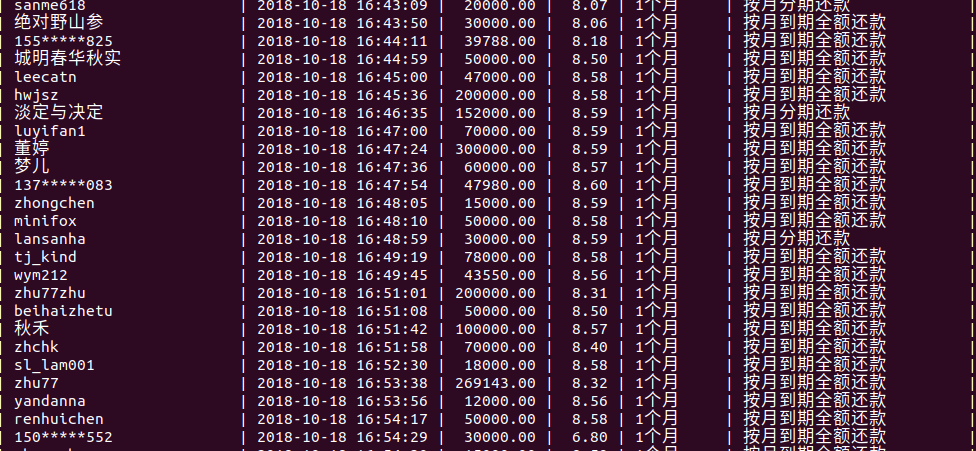如何利用mysql+pyecharts儲存資料並可視化
目標
爬取紅嶺創投(https://www.my089.com/)日投資發標記錄,儲存在mysql資料庫中,
並將資料視覺化以便分析.
行動
爬取資料
通過selenium+FIrefox的無頭模式將需要的資料爬取出來,程式碼實現不在贅述,詳細步驟可檢視我的上一篇圖文(如何利用Python爬取網易新聞),selenium3.11.0版本已經停止對phantomjs的支援,現在可以使用chrome和firefox的無頭模式實現該功能.
開啟無頭模式:
from selenium.webdriver.firefox.options import Options firefox_options=webdriver.FirefoxOptions() firefox_options.add_argument("--headless") firefox_options.add_argument("--disable-gpu")
一個疑問:
使用ubuntu的crontab定時任務執行此爬蟲指令碼時,如果不開啟無頭模式,報錯如下:
selenium.comm.exception.WebDriverException:message:invalid argument :can't
kill an exited process
沒能理解這個報錯的原因,希望與大家一起討論.
儲存資料
資料庫這次選擇了mysql, 首先需要建立自己的資料庫,建立相應表格,這裡推薦使用 Navicat,能夠將資料庫操作圖形化.navicat需要做一些配置,網上有大量教程,建表時需要注意型別,選擇正確的型別在後續使用時會減少很多麻煩,例如:
VARCHAR和CHAR型別
varchar適用場景:
- 字串列的最大長度比平均長度大很多
- 字串列很少被更新
- 使用了多位元組字符集儲存字串(如utf8中的中文和英文)
char適用場景:
- 儲存長度近似的值(md5值,如密碼)
- 儲存短字串
- 儲存經常被更新的字串列
日期型別
TIMESTAMP型別:
- 以yyyy-MM-dd HH:mm:ss格式顯示,佔用4個位元組
- 時間範圍:1970-1-1 到 2038-01-19
DATATIME型別: - 以yyyy-MM-dd HH:mm:ss格式顯示,佔用8個位元組
- 時間範圍:1000-1-1 00:00:00至9999-12-31 23:59:59
插入資料
db=pymysql.connect(host='localhost',user='root',password=
'xxxx',db='hlct',charset='utf8')
sql="INSERT INTO data_1 VALUES('" + dic['借款人'] + "','" +dic['時間']\
+ "','" + dic['借款金額'].replace(',', '')+ "','" + dic['利率'] +\
"','" + dic['期限'] + "','" + dic['還款方式'] + "');"
cursor =db.cursor() #獲取操作遊標
cursor.execute(sql) #執行sql語句
db.commit() #提交到資料庫執行
db.close()
此時,資料已經靜悄悄的待在資料庫中了 xd
利用echarts將資料視覺化作圖
最初我是在這學習的echarts基本操作 ------渲染圖表
針對這次的目標,折線圖是最好的展現資料方式.資料庫原始資料需要做出一定處理,根據具體用途處理就好.
import pyecharts_snapshot
from datetime import datetime ,date, timedelta
from pyecharts import Line
def rLine(y_rate):
x_axis =["00", "01", "02", "03", "04", "05", "06", "07",
"08", "09", "10" ,"11","12", "13", "14", "15", "16", "17", "18", "19",
"20", "21","22","23"]
aver=[];max=[];min=[]
for y in y_rate:
aver.append(y[0])
max.append(y[1])
min.append(y[2])
line = Line("紅嶺創投利率曲線"'('+Date+')')
line.use_theme("dark")
line.add("最高利率", x_axis=x_axis,y_axis=max,yaxis_max=9,
yaxis_min=8,yaxis_force_interval=0.1,
yaxis_formatter='%')
line.render(path='/home/lsgo18/PycharmProjects/honglingchuangtou/rate.png')
- x_axis--------------------------------------橫軸資料
- y_axis--------------------------------------縱軸資料
- line.add()----------------------------新增資料作圖
- yaxis_max--------------------設定縱軸刻度範圍
- yaxis_force_interval--------------設定刻度精度
- line.use_theme--------------------------主題顏色
- line.render()------------------------------生成檔案
crontab定時任務
觀察了紅嶺創投往網站一段時間後,發現只能顯示近十分鐘左右的即時資料,不可能每過幾分鐘手動點選程式執行,夥伴們向我推薦了一個非常好用的指令-----crontab,crontab 是用來讓使用者在固定時間或固定間隔執行程式之用,換句話說,也就是類似使用者的時程表,並且在後臺執行,不會打擾到我們的學習和工作.
- 開啟crontab:
sudo vim /etc/cronta
- 介面如下(通過vim開啟)
基本格式
* * * * * command
分 時 日 月 周 命令
第1列表示分鐘1~59 每分鐘用*或者 */1表示
第2列表示小時1~23(0表示0點)
第3列表示日期1~31
第4列表示月份1~12
第5列標識號星期0~6(0表示星期天)
第6列要執行的命令
通常需要將python環境絕對路徑,程式絕對路徑寫入命令,保證能正常執行,如果crontab沒有執行,大概率的原因就在此,圖中倒數第四行黃色部分就是執行爬蟲的指令,最後/auto.log部分是輸出日誌,將每一次執行的結果寫進日誌檔案,以便檢查執行情況.
smtplib傳送郵件
每天處理資料做出折線圖後,將圖片傳送給團隊老大,smtplib是不錯的選擇,結合crontab就能每天自動執行,成就感超強.
import smtplib
from email import encoders
from email.header import Header
from email.mime.text import MIMEText
from email.mime.base import MIMEBase
from email.mime.multipart import MIMEMultipart
from email.utils import parseaddr, formataddr
def send(self):
from_addr = "[email protected]" # 發件人 Email 地址和口令
password = "xxxxxxx"
smtp_server = "smtp.qq.com" # SMTP 伺服器地址
to_addr = "[email protected]" # 收件人地址
# 郵件頭
msg = MIMEMultipart()#代表郵件本身
msg['From'] = self._format_addr('lsgo <%s>' % from_addr)
msg['To'] = self._format_addr('lsgo <%s>' % to_addr)
msg['Subject'] = Header('紅嶺創投', 'utf-8').encode() # 標題
# 郵件正文
# msg.attach(MIMEText('……', 'plain', 'utf-8'))
# 新增附件
self.addfile(msg)
try:
server = smtplib.SMTP(smtp_server, 25)
server.set_debuglevel(1)
server.starttls()
server.login(from_addr, password)
server.sendmail(from_addr, [to_addr], msg.as_string())
server.quit()
print("郵件傳送成功")
except smtplib.SMTPException:
self.send()
print("Error: 傳送郵件失敗,正在重試!")
在郵件中新增附件:
def _format_addr(self,s):
name, addr=parseaddr(s)
return formataddr((Header(name,'utf-8').encode(),addr))
def _getfile(self):
file='/home/lsgo18/PycharmProjects/honglingchuangtou/'
return [file+'money.png',file+'rate.png']
def addfile(self,msg):
files=self._getfile()
#設定附件的MIME和檔名
attr1 = MIMEBase('image', 'png', filename='file.png')
#必要的頭資訊
attr1.add_header('Content-Disposition', 'attachment',
filename=files[0][-9:])
attr1.add_header('Content-ID', '<0>')
attr1.add_header('X-Attachment-Id', '0')
#讀取附件內容
attr1.set_payload(open(files[0], 'rb+').read())
#用Base64編碼
encoders.encode_base64(attr1)
#新增到MIMEMuptipart
msg.attach(attr1)
# 附件2
attr2 = MIMEBase('image', 'png', filename='file.png')
attr2.add_header('Content-Disposition', 'attachment',
filename=files[1][-8:])
attr2.add_header('Content-ID', '<0>')
attr2.add_header('X-Attachment-Id', '0')
attr2.set_payload(open(files[1], 'rb').read())
encoders.encode_base64(attr2)
msg.attach(attr2)




